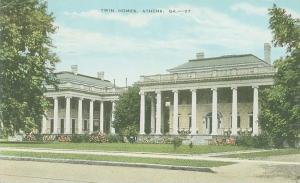More on The Tangible Past in Athens, Georgia
Pub Notes
The Tangible Past in Athens, Georgia will enrage you, rendering you speechless at the incredible architectural riches we have bulldozed. But calm down. Progress comes. We wouldn’t have our beloved downtown if we hadn’t torn down a bunch of old houses to allow our business district to expand, so that it could become the area we revere today. The whole point of this book is that the past is tangible here in Athens, Georgia; it is all around us; it is “not really past.” All we need is a bunch of aunts and uncles to sit around on the porch and tell us the stories that connect the dots and fill in the blanks to decipher the marks still dimly seen on the palimpsest that is our town, helping us understand the value of what is vanished and of what is still visible.
The Tangible Past functions as Athens’ front porch, where one story reminds of another, and the tale of moving a mansion elicits an enumeration of all the structures in Athens that have been moved from one location to another, which leads to a discussion of the families who commissioned and inhabited them, the architects who designed them, the builders who erected them and even the revelation of where fragments of these structures are incorporated into buildings still extant.

The funny thing is that this book started out to be a slender volume about moved houses in Athens. But these aunts and uncles are storytellers. They hijacked that original idea and turned it into a vehicle to tell the never-ending tales of Athens, bolstered by a stunning collection of photographs to provide evidence for what they say, and the rest is history, though it must be stressed that this is not a history of Athens but Athens history.
And what a rich history! These writers explain how Athens came up from the river, extending along Oconee Street to Broad in tandem with the nascent university and over the “next hill” up around Dearing Street to Milledge, which connected Cobbham to Watkinsville, and eventually along Prince, which was originally part of the federal highway that connected us to the Cherokee nation. There are 18 rich chapters here, plus all kinds of appendices, forewords and afterthoughts, in addition to a comprehensive index and bibliography, not to mention an annotated compendium.
The Tangible Past is a big book because of the details. These authors have spent a large part of their lives digging out the facts that are on display here. They have traced old deeds, read diaries and wills and memoirs, talked and corresponded with family members and examined artifacts. The accumulation and ordering and presentation of this information took time and space; this book was years in the making and continued to grow organically, as one story prompted another.
There is simply not room here to lay out the riches within this book. Go pick it up and flip through it. You will be astounded at what it contains, and you will understand why its price of $55 is a great bargain. The Tangible Past will make you stand there and calculate whether you can afford one for yourself and one for others you know who have a connection to Athens. It is Christmas, after all.
The book will be available for purchase at three upcoming reading/signing events in these places: the Russell Special Collections Library on campus at 4 p.m. Thursday, Dec. 4; the Athens Junior League reception and signing from 3–5 p.m. Sunday, Dec. 7 at the Taylor-Grady House on Prince Avenue; and the Athens-Clarke County Library’s “Café au Libris,” which will feature the book at 3 p.m. Sunday, Dec. 14.
The Tangible Past in Athens, Georgia is also on sale at these locations: ADD Drugs, Appointments at Five, Athens Welcome Center, Aurum Studios, Avid Bookshop, Classic Galleries (Watkinsville), The Clubhouse, Thomas R. R. Cobb House, Cullen & Company in The Bottleworks, Harry’s BBQ, Heery’s Too, The Olive Basket in the Bottleworks and the UGA Bookstore, among others.
Keywords
More by Pete McCommons
-
Voting Absentee: Necessary But Not Easy
Pub Notes
-

Be Ready When National TV Comes Calling
Pub Notes
-










comments